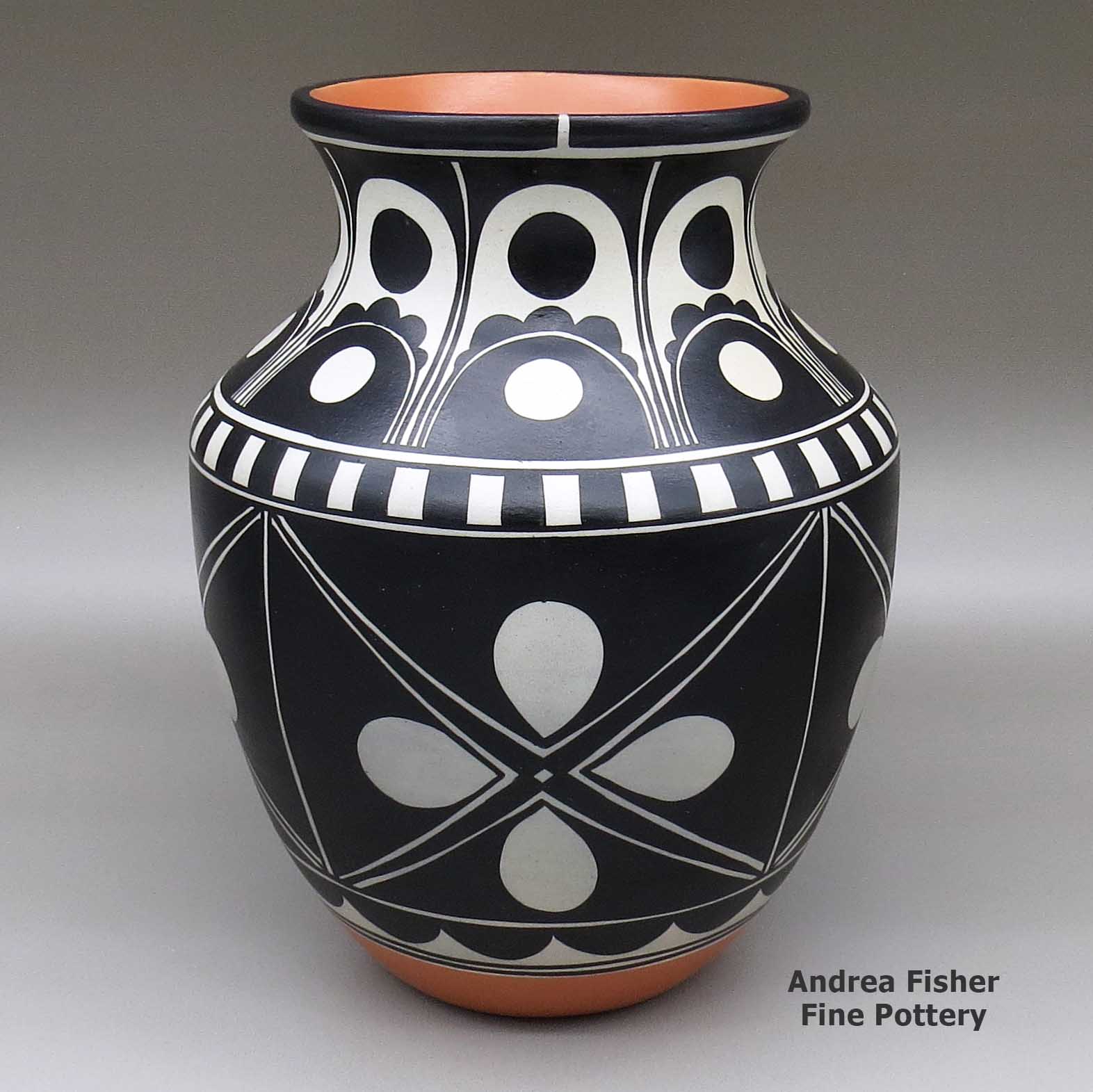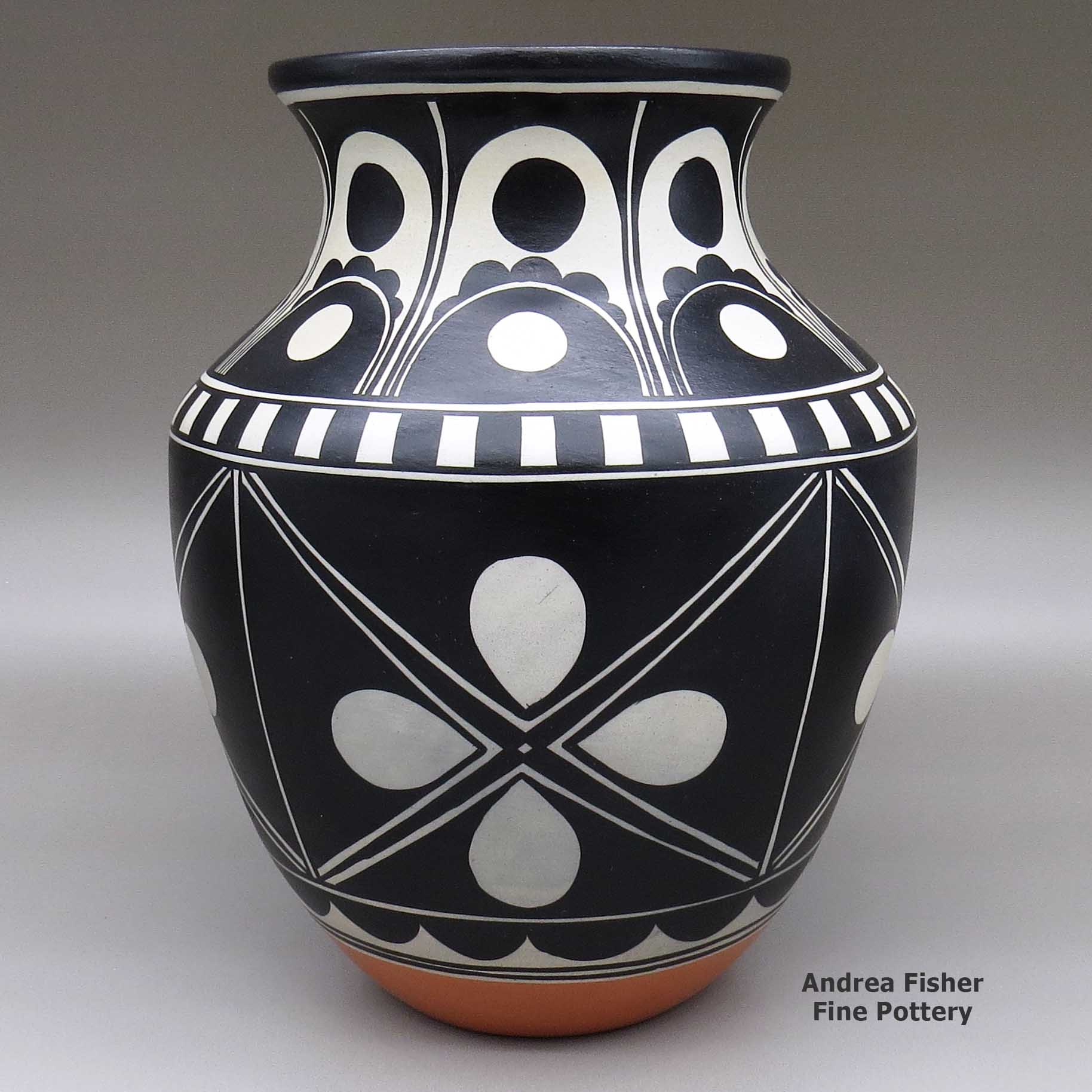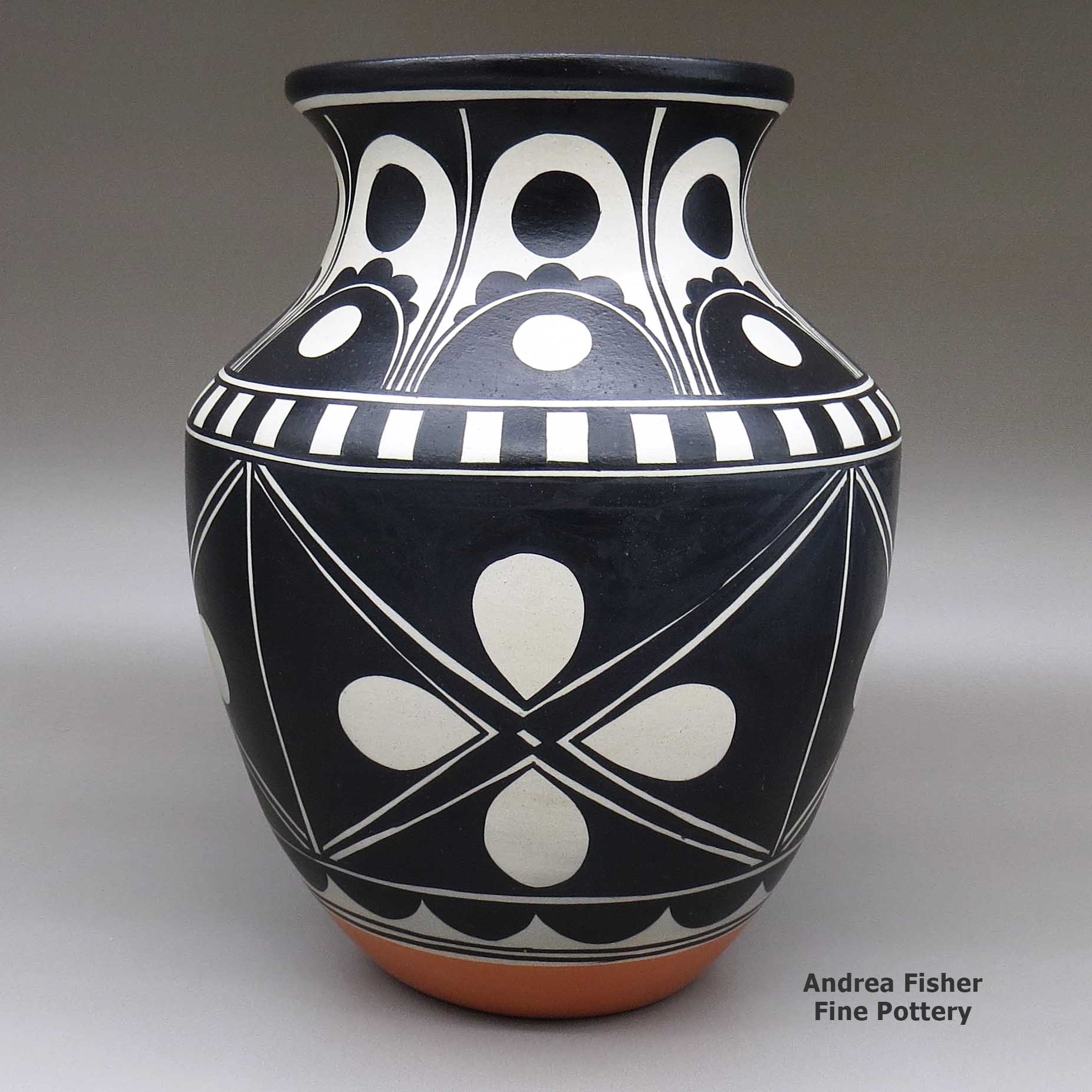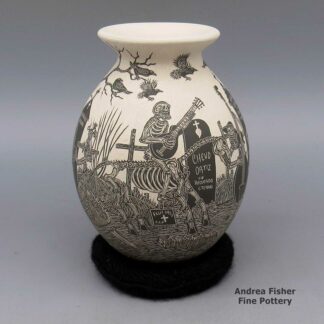| Dimensions | 10 × 10 × 17 in |
|---|---|
| Condition of Piece | Excellent |
| Date Born | 2023 |
| Signature | Thomas Tenorio Kewa, NM |
Thomas Tenorio, zzsd3c161, Polychrome jar with a geometric design
$2,400.00
A polychrome jar with a flared opening and decorated with a traditional Santo Domingo geometric design
In stock
Brand
Tenorio, Thomas
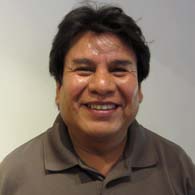 Born in 1963 at Santo Domingo Pueblo, Thomas Tenorio started making pottery in the early 1990s. He grew up thinking he came from a family of heishi makers. Then he found out his maternal great-grandmother made Santo Domingo pots and sold them by the side of the highway in the 1940s. Realizing that these days only a few families continue to make Santo Domingo-style pottery he was inspired to learn so that he could help keep the tradition alive.
Born in 1963 at Santo Domingo Pueblo, Thomas Tenorio started making pottery in the early 1990s. He grew up thinking he came from a family of heishi makers. Then he found out his maternal great-grandmother made Santo Domingo pots and sold them by the side of the highway in the 1940s. Realizing that these days only a few families continue to make Santo Domingo-style pottery he was inspired to learn so that he could help keep the tradition alive.Thomas tells us he is a self-taught potter: "Nobody showed me how. I learned on my own through a lot of trial and error." He does credit Kenneth Chapman’s book The Pottery of Santo Domingo Pueblo for providing him with examples of old Santo Domingo designs.
Thomas uses local Santo Domingo clay which he cleans, mixes, hand-coils, shapes, decorates and then fires outdoors in an open flame, just as his ancestors did for hundreds of years before him. He learned to protect his pots during the firing, surrounding them with a metal cage so no fuel touches them and burns the pot. It took him years to figure out the complicated chemistries of the buff slip and bee weed paint (made from a wild spinach that grows in New Mexico).
Thomas' greatest pleasure comes through recognition of his current work. While he enjoys the process, he "gets lost in the painting and could sit for hours and hours and paint." He especially loves painting the swirls of the water, the wind and the corn. He also loves painting his bowls, especially if they contain fish or a traditional Santo Domingo bird.
Thomas is exploring new shapes and designs on his more recent work but he isn't forgetting the traditional shapes and designs of Kewa on his huge pots.
Thomas read somewhere that he was a miniature potter. We laughed when he told us that, because he is not a short person and some of his more recent pieces have been almost as big as he is.
When we asked him where he gets his inspiration he replied, "My inspiration comes from my traditional faith at home and from nature."
Thomas often participates in the Heard Museum Guild Indian Art Fair (where he earned the 2012 First Place ribbon for Traditional Painted Pottery). He earned the same First Place award at the Heard in 2007 and has earned First and Second Place ribbons at the Santa Fe Indian Market in 2015, 2014, 2011 and 2010. We are sure there are more, it's just hard to keep up.
In 2013 Thomas had an extremely successful one-man show at Andrea Fisher Fine Pottery where he did an outdoor firing demonstration for some of our best customers.
Thomas signs his pottery "Thomas Tenorio, Kewa, NM" and sometimes adds the year. His pottery can be found in the collections of:
- The White House, Washington, DC
- Rockefeller Museum, New York City
- Smithsonian Institute, Washington, DC
- Museum of Indian Arts & Culture, Santa Fe, NM
- Pueblo Grande Museum, Phoenix, AZ
- Crocker Art Museum, Sacramento, CA
Some Awards Earned by Thomas
- 2023 Santa Fe Indian Market, Classification IIB, Category 603 - Painted polychrome pottery in the style of Cochiti, Santo Domingo, Santa Clara, San Ildefonso, Tesuque, Nambe, San Juan, Pojoaque, Any form, Second Place
- 2023 Santa Fe Indian Market, Classification IIB, Category 605 - Figures/Manas, Second Place
- 2018 Santa Fe Indian Market, Classification II - Pottery, Division B - Traditional Painted Pottery, Category 603 - Painted Polychrome Pottery in the Style of Cochiti, Santo Domingo, Santa Clara, San Ildefonso, Tesuque, Nambe, San Juan, Pojoaque, Any Form: First Place
- 2018 Santa Fe Indian Market, Classification II - Pottery, Division B - Traditional Painted Pottery, Category 603 - Painted Polychrome Pottery in the Style of Cochiti, Santo Domingo, Santa Clara, San Ildefonso, Tesuque, Nambe, San Juan, Pojoaque, Any Form: Second Place
- 2018 Santa Fe Indian Market, Pueblo Pottery Excellence Award. For Creative Excellence in the Use of Traditional Materials and Native Techniques and Designs in Pueblo Pottery
- 2012 Heard Museum Guild Indian Fair & Market. Heard Museum. Phoenix, AZ. Class. II - Pottery, Div. A - Traditional, native clay, hand build, painted, First Place
- 2010 Heard Museum Guild Indian Fair & Market. Phoenix, AZ. Class. II - Pottery, traditional, native clay, hand built, painted, Honorable Mention
- 2008 Heard Museum Guild Indian Fair & Market. Heard Museum. Phoenix, AZ. Class. II - Pottery, Div. A - Traditional, Native clay, hand built, painted, First Place
A Short History of Santo Domingo Pueblo
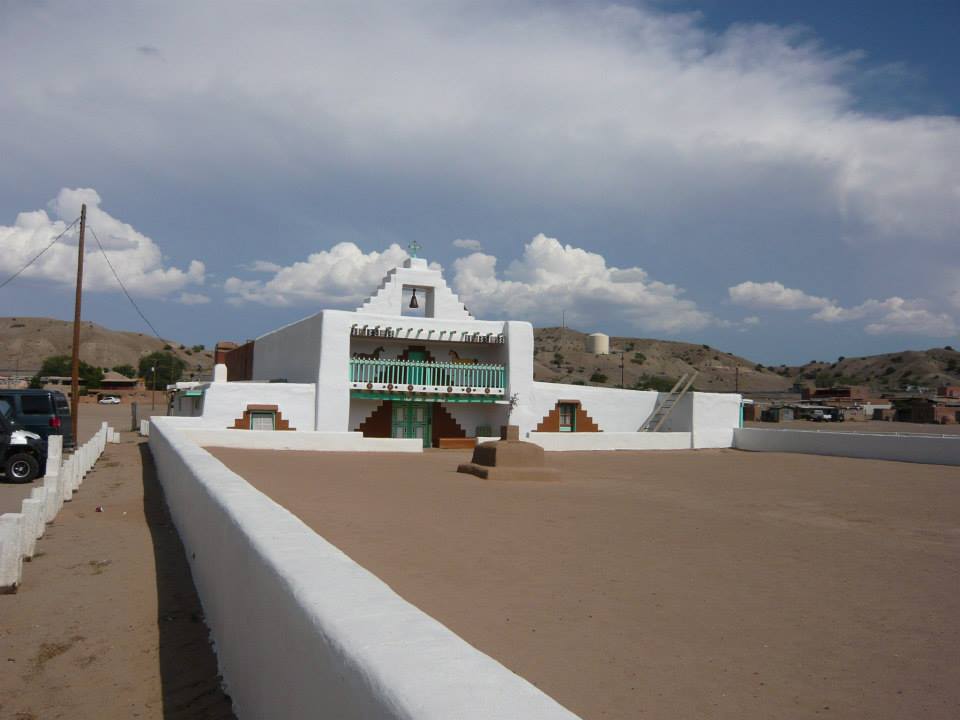
Santo Domingo Pueblo is located on the east bank of the Rio Grande about half-way between Santa Fe and Albuquerque. Historically, the people of Santo Domingo were among the most active of Pueblo traders. The pueblo also has a reputation of being ultra traditional, probably due, at least in part, to the longevity of the pueblo's pottery styles. Some of today's popular designs have changed very little since the 1700's.
In pre-Columbian times, traders from Santo Domingo were trading turquoise (from mines in the Cerrillos Hills) and hand-made heishe beads as far away as central Mexico. Many artisans in the pueblo still work in the old ways and produce wonderful silver and turquoise jewelry and heishe decorations.
Like the people of nearby San Felipe and Cochiti, the people of Santo Domingo speak Keres and trace their ancestry back to villages established in the Pajarito Plateau area in the 1400s. Like the other Rio Grande pueblos, Santo Domingo rose up against the Spanish oppressors in 1680, following Alonzo Catiti as he led the Keres-speaking pueblos and worked with Popé (of San Juan Pueblo) to stop the Spanish atrocities. However, when Spanish Governor Antonio Otermin returned to the area in 1681, he found Santo Domingo deserted and ordered it burned. The pueblo residents had fled to a nearby mountain stronghold and when Don Diego de Vargas returned to Nuevo Mexico in 1692, he attacked that mountain fortress and burned it, too. Catiti died in that battle and Keres opposition to the Spanish crumbled with his death. The survivors of that battle fled, some to Acoma, some to fledgling Laguna, some to the Hopi mesas. Over time most of them returned to Santo Domingo.
In the late 1690s, Santo Domingo accepted an influx of refugees from the Galisteo Basin area as they fled drought and the near-constant attacks of Apache, Comanche, Ute and Navajo raiders in that area.
Today's main Santo Domingo village was founded about 1886.
In 1598 Santo Domingo was the site of the first gathering of 38 pueblo governors by Don Juan de Oñaté. He attempted to force them to swear allegiance to the crown of Spain. Today, the All Indian Pueblo Council (consisting of the nineteen remaining pueblo's governors and an executive staff) gathers at Santo Domingo for their first meeting every year, to continue what is now the oldest annual political gathering in America. During the time of the Spanish occupation, Santo Domingo served as the headquarters of the Franciscan missionaries in New Mexico and religious trials were held there during the Spanish Inquisition.
Today, the people of Santo Domingo number around 4,500 with about two-thirds of them living on the reservation.
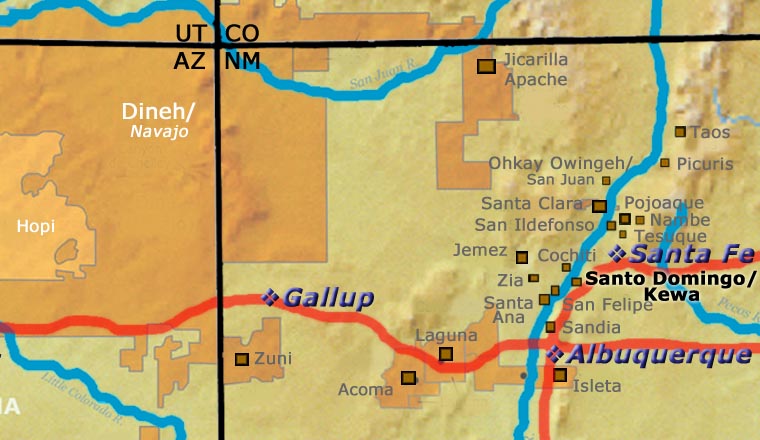
For more info:
Pueblos of the Rio Grande, Daniel Gibson, ISBN-13:978-1-887896-26-9, Rio Nuevo Publishers, 2001
Photo courtesy of Wikimedia Commons, Creative Commons Attribution-Share Alike 3.0 Unported License
Traditional Santo Domingo Design
Santo Domingo is considered a very conservative pueblo, especially when it comes to their religion. Their religion affects every aspect of the people's lives at Santo Domingo. Due to what has happened to them since Coronado and his men first arrived, they have become very secretive in regards to every aspect of their religious practices.
For example, artists are not allowed to depict human forms, especially on products meant for sale to outsiders. That restricts the artist's palette to images of birds, flowers, fish and various geometric patterns symbolizing water, forest, clouds, rain and lightning bolts. There is also a tradition at Santo Domingo of painting their pots completely in the negative using black and red pigments, rather than just painting in black and red on their usual "white" background slip.
Back in the 1920s, Kenneth Chapman, from the Museum of New Mexico, became worried that the Santo Domingo pottery tradition was dying. So he went there and, sitting among the potters, he copied the designs each were painting on their pots and made a book of those. Thomas Tenorio has told us that book is where he got many of his designs from.
About Jars
The jar is a basic utilitarian shape, a container generally for cooking food, storing grain or for carrying and storing water. The jar's outer surface is a canvas where potters have been expressing their religious visions and stories for centuries.
In Sinagua pueblos (in northern Arizona), the people made very large jars and buried them up to their openings in the floors of the hidden-most rooms in their pueblo. They kept those jars filled with water but also kept smaller jars of meat and other perishables inside those jars in the water. It's a form of refrigeration still in use among indigenous people around the world.
Where bowls tend to be low, wide and with large openings, jars tend to be more globular: taller, less wide and with smaller openings.
For a potter looking at decorating her piece, bowls are often decorated inside and out while most jars are decorated only on the outside. Jars have a natural continuity to their design surface where bowls have a natural break at the rim, effectively yielding two design surfaces on which separate or complimentary stories can be told.
Before the mid-1800s, storage jars tended to be quite large. Cooking jars and water jars varied in size depending on how many people they were designed to serve. Then came American traders with enameled metal cookware, ceramic dishes and metal eating utensils...Some pueblos embraced those traders immediately while others took several generations to let them and their innovations in. Either way, opening those doors led to the virtual collapse of utilitarian pottery-making in most pueblos by the early 1900s.
In the 1920s there was a marked shift away from the machinations of individual traders and more toward marketing Native American pottery as an artform. Maria Martinez was becoming known through her exhibitions at various major industrial fairs around the country and Nampeyo of Hano was demonstrating her art for the Fred Harvey Company at the Grand Canyon. The first few years of the Santa Fe Indian Market helped to solidify that movement and propel it forward. It took another couple generations of artists to open other venues for their art across the country and turn Native American art into the phenomenon it has become.
Today's jars are artwork, not at all for utilitarian purposes, and their shapes, sizes and decorations have evolved to reflect that shift.
